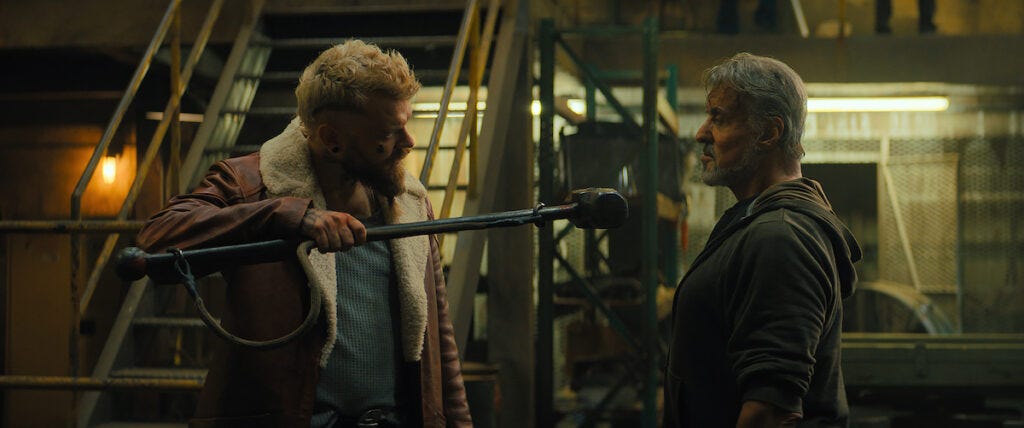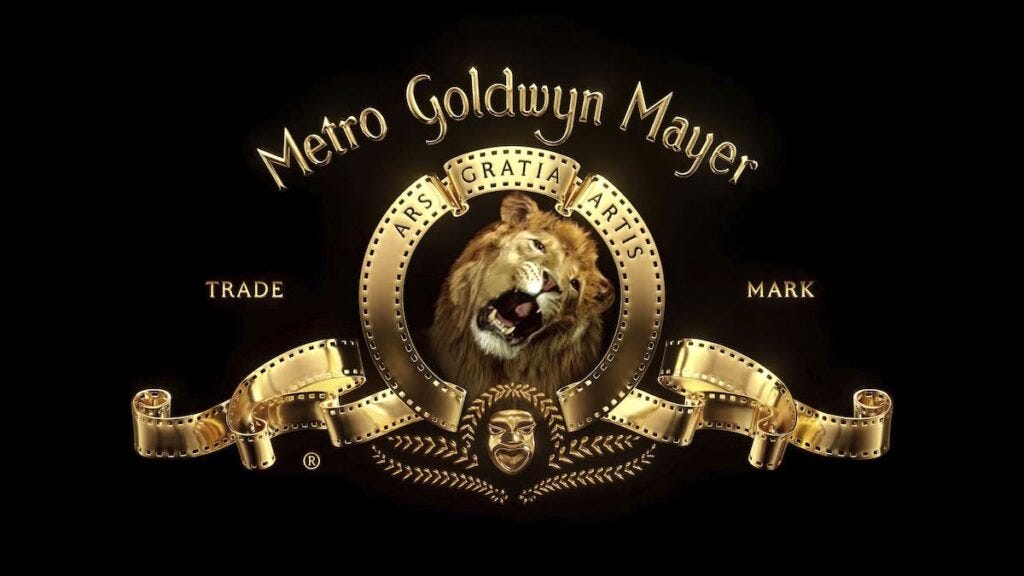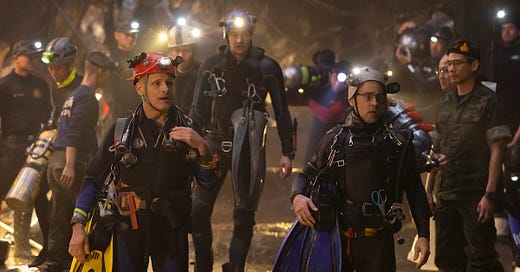‘Thirteen Lives’ and ‘Samaritan’ Reviews
A rescue thriller that works, a superhero story that doesn’t quite, and the great flattening.
Thirteen Lives, the real-life story of the rescue of a soccer team running out of air in a flooded cave in Thailand, is Ron Howard’s best movie since Apollo 13, the story of the real-life effort to save a trio of astronauts from running out of air in a spacecraft headed to the moon.
Ron Howard: the auteur of asphyxiation!
What both films present is a sort of promise. “Here’s a true-to-life story,” Howard is telling us. “I know how it ends. You know how it ends. You know it ends well. You know that the story is going to come out okay for most everyone involved. I’m going to take that knowledge and use it as an excuse to make you as tense as possible for the next couple of hours. Deal?”
And then he lives up to his part of the deal. Boy does he.
Personally, Thirteen Lives is like an amalgamation of my greatest fears, a nigh-on unbearably tense mixture of pitch-black chest-tightening claustrophobia, compounded with a heavy dose of thalassophobia, combined with the universally shared dread any time a child is shown to be in danger. In this case, 12 such children, along with the coach who kept them calm and patient while waiting for rescue.
Rescue comes not in the form of Thailand’s SEAL Team, which is unable to navigate the inky-black, stalactite-strewn waterways, but a handful of amateur cave divers from halfway around the world. John Volanthen (Colin Farrell) and Rick Stanton (Viggo Mortensen) answer the call, joining thousands of others who flocked to the site just to help. One such individual is Thanet Natisri (Nophand Boonyai), an engineer who devises a series of damns and tunnels to divert as much of the monsoon-season rain as possible from entering the mountain in an effort to calm the raging underwater rapids.
“No, I just came like everyone else,” Thanet says when a local villager asks if the government sent for him. “There’s no time to wait for help from the officials.”
Time was the tricky thing, of course. The kids were running out of time, at least in the sense that time equals air and food. But rushing promised disaster of another kind: images of divers being pulled from the cave dead. The rescuers had to wait just long enough for the waters to recede somewhat but not so long that the kids died. It’s a perfect recipe for the sort of unbearable procedural tension that Howard excels at dramatizing.
Thirteen Lives isn’t overly stylized, but that’s not say it’s lacking in style. Howard and his cinematographer Sayombhu Mukdeeprom, a Thai native, manage to get us underwater with Volanthen, Stanton, and their fellow divers; our point of view is knocked around just like theirs, swirling through underwater currents and prone to taking a blow to the head. No one is more sympathetic than the Thai diver who panics, breaks for the surface, and bangs his head on the rocks above.
One sensation cinema has always been good at recreating, at least within me, is claustrophobia. I can remember seeing Kill Bill Vol. 2 for the first time and nearly squirming out of my seat with the Bride (Uma Thurman) was nailed into a coffin and buried six feet under. I barely got through The Descent, about a spelunking trip that manages to increase the terror of squeezing through narrow rock passages for no good reason by throwing CHUDs into the mix.
But Thirteen Lives is tolerable because of the Ron Howard guarantee: We know it’s all going to work out, more or less. So sit back and enjoy the chest-tightening terror; the catharsis of community victory will be worth it.

Pilou Asbæk and Sylvester Stallone in 'Samaritan'
When the movie Den of Thieves came out, a certain subset of somewhat snide movie reviewer called the picture “Idiot Heat.” (I both enjoyed the movie and am guilty of using this label, your honor; I throw myself on the mercy of the court.) The idea being that Den of Thieves and Heat had a similar thrust (we follow a team of cops and a team of criminals as the criminals prep a big score and the lead cop tries to hold his family together in both) and some similar sequences (both pictures feature a great shootout on a California road), all while being about 30 percent dumber.
If Den of Thieves is “Idiot Heat,” then Samaritan is “Idiot Dark Knight Rises.” Both Samaritan and The Dark Knight Rises have a similar thematic thrust (the need for heroes and heroism to help a city racked by economic turmoil regain its balance). In Christopher Nolan’s epic the hero, of course, is Batman; here it’s Samaritan, who was born with superpowers like his brother, Nemesis. Following the death of their parents, the brothers turned against each other, eventually getting into a fight that caused a power plant to explode, and they both disappeared, assumed dead. A boy is convinced his garbage-man neighbor Joe Smith (Sylvester Stallone) is Samaritan and, shocker, it turns out he has superpowers—but needs a nudge to get back in the game.
Meanwhile, Samaritan’s villain, Cyrus (Pilou Asbæk), has cribbed from The Dark Knight Rises’s Bane not only ideological tics (giving speeches about the need for people to take back their city via riots and the need to punish the police, who protect the powerful at the expense of the weak) but also fashion tips (Cyrus delivers these speeches in a shearling jacket and mask). Hell, Cyrus even shoots a guy in the back after promising him freedom, saying “Always give people hope” after he does it.
Again: Idiot Dark Knight Rises.
All of which is to say that Samaritan feels like a pale imitation of something better and more serious. It’s not terrible, exactly—director Julius Avery does a good job of framing and pacing every scene; it’s never quite visually interesting but we generally have a pretty good idea of what is happening and where it’s happening, and there’s something to be said for quiet competence—and I generally enjoy seeing Sylvester Stallone do the broken-down-old-man-pulls-one-last-job thing that has come to define the last decade and a half of his career.
But the plotting leaves much to be desired, to the extent that, following the film’s big twist, I wasn’t sure why Samaritan and Nemesis had their knock-down, drag-out fight that occurred before the events of this film or even, really, what Nemesis stood for or why he was a villain or what Cyrus is doing that imitates him. None of it really made much sense.
The movie’s a mess, is what I’m saying, but at least it’s more or less watchable.

Like Thirteen Lives, Samaritan is available now on Amazon Prime. Like Thirteen Lives, Samaritan features real stars—or, at least, a star in the form of Stallone. And like Thirteen Lives, Samaritan looks like a proper movie, one that’s shot and framed with some skill and care.
Unlike Thirteen Lives, Samaritan isn’t very good. But the not-very-good Samaritan and the really-quite-good Thirteen Lives live on the same platform, one click away from each other when you pop open that Prime Video tab. They’re both refugees from Amazon’s purchase of MGM last year, orphaned titles that are too dicey a commercial proposition to put in theaters. And the fact that reside next to each other, no real suggestion of their relative qualities, is one of the more annoying effects of our flattened, post-theatrical world.
Once upon a time, a movie like Samaritan would go straight to DVD and folks who recognized Sly’s face would grab it from a Redbox kiosk or spend $9.99 on it at Walmart and have a nice night in. Meanwhile, Thirteen Lives would hit theaters and do decent-but-still-modest business there on strong word of mouth before becoming an awards-season contender due to its Oscar-caliber lineage. Audiences would instinctively understand the difference between the two, which would in turn allow them to more easily prioritize their viewing: Sometimes we’re in the mood for something good and sometimes we’re in the mood for trash. No shame in that.
But the great flattening makes these distinctions harder to parse, mostly to the detriment of better work. Just speaking for myself: It took me a few extra weeks to get to Thirteen Lives because I assumed it would be about as good as Howard’s previous straight-to-streaming title, Hillbilly Elegy, rather than about as good as his last theatrical disaster flick, Apollo 13.
Yes, yes: You know what happens when you assume, etc. But we’ve been trained to make these assumptions for decades by the industry. It’s going to take some time to figure out how the new mental heuristics are supposed to work.





